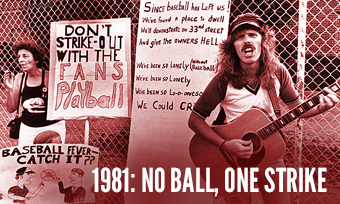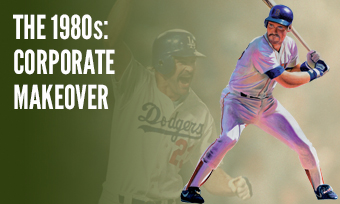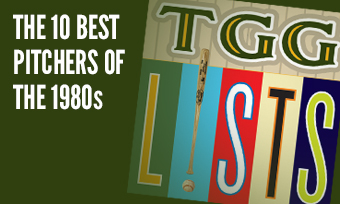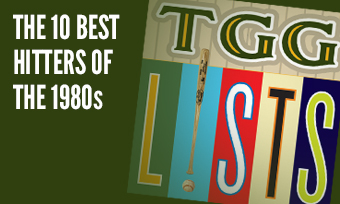The Yearly Reader
Leaders and Honors, 1981
Our list of baseball’s top 10 hitters and pitchers in both the American League and National League for the 1981 baseball season, as well as the awards and honors given to the game’s top achievers of the year.
The National League’s Top 10 Hitters, 1981
Bold type in brick red indicates league leader.
1. Mike Schmidt, Philadelphia
Key Numbers: .316 average, 78 runs, 112 hits, 19 doubles, 31 home runs, 91 RBIs, 73 walks, 18 intentional walks, 12 stolen bases, .435 on-base percentage, .644 slugging percentage.
One shudders to think what kind of numbers Schmidt might have racked up had the strike not stripped him of a third of the season. We’ll pace it out for you anyway: 47 home runs and 138 RBIs. (If you basically want 162-game projections for everybody on this page, just divide the numbers by two and multiply by three—except averages, of course.)
2. Andre Dawson, Montreal
Key Numbers: .302 average, 71 runs, 119 hits, 21 doubles, 24 home runs, 64 RBIs, 7 hit-by-pitches, 26 stolen bases.
Dawson could have easily become Montreal’s first 30-30 ballplayer had it not been for the strike; Expos fans would have to wait until Vladimir Guerrero (in 2001) finally reached the milestone.
3. George Foster, Cincinnati
Key Numbers: .295 average, 64 runs, 122 hits, 23 doubles, 22 home runs, 90 RBIs.
Foster had one last productive fling at Cincinnati before initiating an unhappy tenure at New York.
4. Gary Matthews, Philadelphia
Key Numbers: .301 average, 62 runs, 21 doubles, 9 home runs, 67 RBIs, 59 walks, 15 stolen bases.
Though with light round-tripper muscle, Matthews satisfied Phillies front-office personnel who agreed to take him off the hands of a Braves team that didn’t want to grant him another voluminous contract.
5. Tim Raines, Montreal
Key Numbers: 88 games, .304 average, 61 runs, 13 double, 7 triples, 5 home runs, 37 RBIs, 71 stolen bases.
Among the would-haves and should-haves from the strike-shortened campaign: An outside shot for rookie Raines, the latest Montreal sonic-speedster, to break Lou Brock’s season stolen base record.
6. Keith Hernandez, St. Louis
Key Numbers: .306 average, 65 runs, 115 hits, 27 doubles, 4 triples, 8 home runs, 48 RBIs, 61 walks, 12 stolen bases.
Hernandez managed to hit over .300 for a third straight year despite a deepening cocaine addiction that would muffle what could have been his peak years.
7. Bill Madlock, Pittsburgh
Key Numbers: 82 games, .341 average, 23 doubles, 6 home runs, 45 RBIs, 18 stolen bases.
The perennial .300 hitter complained at spring camp that he wouldn’t win a third batting title batting in the six-spot of the Pirates’ order. But after a hot start, the Bucs smartly moved him up to bat third and, sure enough, he got his crown.
8. George Hendrick, St. Louis
Key Numbers: .284 average, 67 runs, 112 hits, 19 doubles, 18 home runs, 61 RBIs.
Putting up numbers comparable to his strong 1980 results (on a per-game basis, anyway), Hendrick was equally good in each half of the season—just like the Cardinals in total, though it criminally wasn’t good enough to get them into the expanded postseason.
9. Bill Buckner, Chicago
Key Numbers: .311 average, 131 hits, 35 doubles, 10 home runs, 75 RBIs.
Billy Buckshoes was one of the few saving graces of a really bad (38-65) Cubs team, on pace to hit over 50 doubles and knock in well over 100 runs.
10. Pete Rose, Philadelphia
Key Numbers: .325 average, 73 runs, 140 hits, 18 doubles, 5 triples, 0 home runs, 33 RBIs.
For the second time, Rose was robbed of a 200-hit season due to a work stoppage (he collected 198 in a 1972 campaign shortened by eight games). On June 2 against the Mets, he became the first player age 40 or over since Sam Rice in 1930 to hit two triples in a game.
The American League’s Top 10 Hitters, 1981
1. Dwight Evans, Boston
Key Numbers: .296 average, 84 runs, 122 hits, 19 doubles, 4 triples, 22 home runs, 71 RBIs, 85 walks.
There wasn’t anything eye-popping about Evans’ stats until you discover it historically took him 162 games, not 108, to put up similar figures.
2. Rickey Henderson, Oakland
Key Numbers: .319 average, 89 runs, 135 hits, 18 doubles, 7 triples, 6 home runs, 35 RBIs, 64 walks, 56 stolen bases, 22 caught stealing.
Had he been given a full season, Henderson might have surpassed both 200 hits and 100 walks; he finished a close second to Rollie Fingers in the AL MVP count (319-308).
3. Eddie Murray, Baltimore
Key Numbers: .294 average, 57 runs, 111 hits, 21 doubles, 22 home runs, 78 RBIs.
Steady Eddie claimed the lone home run title of his Hall-of-Fame career, even if he did have to share the lead with three other players (Dwight Evans, Bobby Grich and Tony Armas).
4. Tom Paciorek, Seattle
Key Numbers: .326 average, 132 hits, 28 doubles, 14 home runs, 66 RBIs, 13 stolen bases.
The career part-timer easily proved he could play every day and became an instant fan favorite in Seattle.
5. Bobby Grich, California
Key Numbers: .304 average, 56 runs, 22 home runs, 61 RBIs, .543 slugging percentage.
How the Grich stole California: On a star-studded Angels team loaded with marquee performers (Fred Lynn, Rod Carew, Don Baylor), the long-time supporting cast member took center stage.
6. Cecil Cooper, Milwaukee
Key Numbers: .320 average, 70 runs, 133 hits, 35 doubles, 12 home runs, 60 RBIs.
On a Brewers team that struggled to hit (but not win), Cooper emerged as the most reliable veteran by hitting over .300 for the fifth of seven straight seasons.
7. Carney Lansford, Boston
Key Numbers: .336 average, 61 runs, 134 hits, 23 doubles, 4 home runs, 52 RBIs, 15 stolen bases.
Lansford won his first and only batting title, but he was just an ankle injury away from being replaced by another batting champ (Wade Boggs).
8. Gorman Thomas, Milwaukee
Key Numbers: .259 average, 54 runs, 22 doubles, 21 home runs, 65 RBIs.
The Brewers’ slugger managed to finally get his batting average over the .250 mark for the first time since he became an everyday regular; 15 of his 21 homers were crushed in the season’s first half.
9. Dave Winfield, New York
Key Numbers: .294 average, 52 runs, 114 hits, 25 doubles, 13 home runs, 68 RBIs, 11 stolen bases.
The über-talented Winfield began a tormented tenure in Steinbrennerland with an agreeable—but not entirely superlative—set of numbers.
10. Chet Lemon, Chicago
Key Numbers: .302 average, 50 runs, 23 doubles, 6 triples, 9 home runs, 50 RBIs, 13 hit-by-pitches.
The unheralded but not always unhurt (13 HBPs in a short season) Lemon enjoyed his last of seven years with the White Sox, before being traded to Detroit one-up for Steve Kemp.
The National League’s Top 10 Pitchers, 1981
1. Jerry Reuss, Los Angeles
Key Numbers: 2.30 ERA, 10 wins, 4 losses, .714 win percentage, 22 starts, 152.2 innings, 27 walks, 18 grounded into double plays.
For all the attention afforded to Fernandomania, teammate Reuss actually had a better ERA (1.90) through the season’s first half—and complemented his overall regular season performance with 18 shutout innings thrown against Houston in the divisional series.
2. Nolan Ryan, Houston
Key Numbers: 1.69 ERA, 11 wins, 5 losses, .688 win percentage, 21 starts, 149 innings, 16 wild pitches, 21 stolen bases allowed.
In his second year with the Astros, Ryan delivered a career-best ERA and fifth no-hitter; four teams (Cubs, Dodgers, Expos and Mets) couldn’t notch a single earned run off him over 52 combined innings.
3. Steve Carlton, Philadelphia
Key Numbers: 2.42 ERA, 13 wins, 4 losses, .765 win percentage, 24 starts, 10 complete games, 190 innings, 179 strikeouts, 9 wild pitches.
Carlton pitched well enough to earn his fourth Cy Young Award, but maybe voters got bored of picking him and gave it to Fernando.
4. Fernando Valenzuela, Los Angeles
Key Numbers: 2.48 ERA, 13 wins, 7 losses, 25 starts, 11 complete games, 8 shuouts, 192.1 innings, 180 strikeouts, 25 stolen bases allowed.
Even within a condensed season, Valenzuela still broke the NL rookie record with eight shutouts.
5. Bob Knepper, Houston
Key Numbers: 2.18 ERA, 9 wins, 5 losses, 22 starts, 5 shutouts, 156.2 innings, 16 grounded into double plays.
Knepper may have been the most effective nine-game winning starter, halving his ERA from the previous two years at San Francisco.
6. Don Sutton, Houston
Key Numbers: 2.61 ERA, 11 wins, 9 losses, 23 starts, 158.2 innings, 29 walks.
Stingy as ever, Sutton spurned the Yankees and headed for the quieter, more expansive pastures of the Astrodome—where he produced a 1.22 ERA in eight starts.
7. Tom Seaver, Cincinnati
Key Numbers: 2.54 ERA, 14 wins, 2 losses, .875 win percentage, 23 starts, 166.1 innings, 23 stolen bases allowed.
The 36-year-old Seaver’s performance was so good, he nearly stole the Cy Young Award from Fernando Valenzuela—losing in the final vote tally, 70-67.
8. Burt Hooton, Los Angeles
Key Numbers: 2.28 ERA, 11 wins, 6 losses, 23 starts, 142.1 innings, 33 walks, 18 stolen bases allowed.
Valenzuela actually had the third-best ERA just on the Dodgers; Hooton had everyone beat with a personal-best figure.
9. Rick Camp, Atlanta
Key Numbers: 1.78 ERA, 9 wins, 3 losses, .750 win percentage, 17 saves, 5 blown saves, 48 appearances, 76 innings, 12 walks.
The reinvention of Camp continued, posting his second straight sub-2.00 ERA.
10. Bill Gullickson, Montreal
Key Numbers: 2.80 ERA, 7 wins, 9 losses, 22 starts, 157.1 innings, 15 stolen bases allowed.
Here’s the primary reason that the 22-year-old Gullickson didn’t sport a more deserving record: Tim Raines and Andre Dawson, easily the Expos’ two best hitters, batted just .246 when he started. (When he didn’t pitch, they hit .316.)
The American League’s Top 10 Pitchers, 1981
1. Steve McCatty, Oakland
Key Numbers: 2.33 ERA, 14 wins, 7 losses, 22 starts, 16 complete games, 4 shutouts, 185.2 innings.
McCatty emerged as the most prominent workhorse of workhorses on the A’s staff, helping Oakland to complete 60 games overall—nearly on pace with their 1980 total.
2. Larry Gura, Kansas City
Key Numbers: 2.72 ERA, 11 wins, 8 losses, 23 starts, 172.1 innings, 35 walks.
Gura’s second-half numbers (7-3, 1.25 ERA) were crucial in getting the Royals to a second-half ‘title’ and a spot in the playoffs with an overall 50-53 record.
3. Rollie Fingers, Milwaukee
Key Numbers: 1.04 ERA, 6 wins, 3 losses, 28 saves, 6 blown saves, 47 appearances, 78 innings, 13 walks.
The veteran closer was never more automatic than in his first year at Milwaukee, where he became instantly loved not only by Brewers fans but also by the BBWAA—which handed him both the AL Cy Young and MVP awards.
4. Dave Righetti, New York
Key Numbers: 2.05 ERA, 8 wins, 4 losses, 15 starts, 105.1 innings.
Even with Madison Avenue right down the street, Righettimania never quite broke out in New York like it did with Fernando Valenzuela in Los Angeles. That was puzzling, considering Righetti’s excellent rookie showing—on the heels of a 5-0, 1.60 ERA start at Triple-A Columbus.
5. Dennis Lamp, Chicago
Key Numbers: 2.41 ERA, 7 wins, 6 losses, 27 appearances, 10 starts, 127 innings, 18 stolen bases allowed.
A failure as a starter the year before, Lamp was demoted to the bullpen—where he found his better pitching self, serving him well over his remaining 12 big-league seasons.
6. Jack Morris, Detroit
Key Numbers: 3.05 ERA, 14 wins, 7 losses, 25 starts, 198 innings, 78 walks, 14 stolen bases allowed, 25 grounded into double plays.
Morris got off to a sharp start in a decade in which he’d win more games than any other pitcher.
7. Ken Forsch, California
Key Numbers: 2.88 ERA, 11 wins, 7 losses, 20 starts, 4 shutouts, 153 innings, 27 walks, 19 grounded into double plays.
Dealt to Anaheim in a trade that would serve both the Astros and Angels well (Houston got Dickie Thon), Forsch was at his best before the strike, winning nine games.
8. Dennis Martinez, Baltimore
Key Numbers: 3.32 ERA, 14 wins, 5 losses, .737 win percentage, 24 starts, 179 innings, 15 stolen bases allowed.
The Nicaraguan’s superb 1981 season prompted the Orioles to hand him a five-year contract—which would prove a disaster as Martinez began sinking more and more into alcohol.
9. Sammy Stewart, Baltimore
Key Numbers: 2.32 ERA, 4 wins, 8 losses, 4 saves, 29 appearances, 3 starts, 112.1 innings.
Even with a 4-8 record, reliever Sammy Stewart won the AL ERA title—but then he didn’t, thanks to a strange interpretation in which rounding out to the nearest full inning gave Steve McCatty the honor instead. (The rule was changed for 1982, and most people now except Stewart as the winner.)
10. Dennis Leonard, Kansas City
Key Numbers: 2.99 ERA, 13 wins, 11 losses, 26 starts, 201.2 innings, 41 walks, 15 stolen bases allowed.
Had it not been for the strike, it’s possible that Leonard—not Steve Carlton in 1980—would have been the last pitcher to date to amass 300 innings in a season. (He was on pace for 317.)









